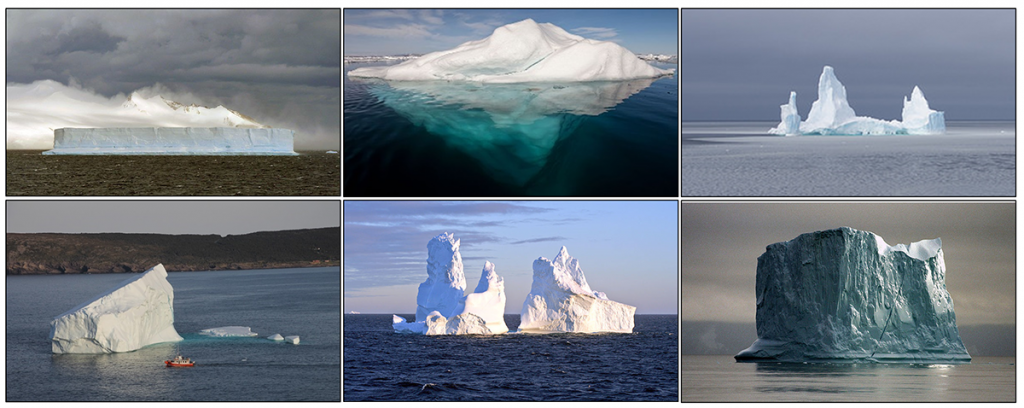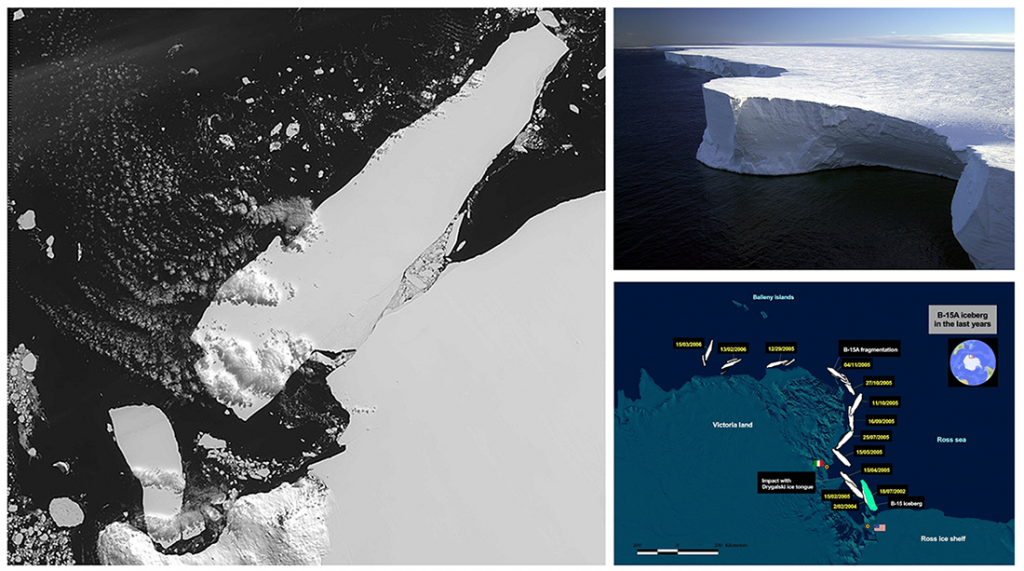14.2 Icebergs
Many of the most spectacular ice formations in the ocean take the form of icebergs. Remember that the largest icebergs are not made of sea ice; they are floating pieces of glaciers that have broken off, or calved from the glacier tongue, and thus they are composed of fresh water ice.
Glacial ice forms from layers of snow that accumulate over time. The weight of the accumulated layers compresses the snow into a granular form known as firn that has a higher density and less air than regular snow. As the pressure from the continued snow accumulation increases, the firn is compressed into even denser glacial ice (Figure 14.2.1). Most icebergs appear white because the ice still contains a lot of air bubbles that scatter all of the wavelengths of white light. But icebergs composed of older ice, or highly compressed ice from deep within a glacier can appear a deep shade of blue (Figure 14.2.1). This ice contains much less air, and larger, denser ice crystals that absorb the longer (red) wavelengths of light, and transmit and scatter the shorter, blue wavelengths. The longer the path that light travels through the ice, the more the long wavelengths are absorbed, and the bluer the ice appears.

Icebergs come in a wide range of sizes, from a few meters across to hundreds of kilometers long. Table 14.2.1 shows the size categories used in the North Atlantic (in the Antarctic a different scale is used, as the icebergs tend to be larger there).
Table 14.2.1 Iceberg size classifications for the North Atlantic
| Size Category | Height (m) | Length (m) |
|---|---|---|
| Growler | < 1 | < 5 |
| Bergy Bit | 1-5 | 5-15 |
| Small | 5-15 | 15-60 |
| Medium | 16-45 | 61-120 |
| Large | 46-75 | 121-200 |
| Very Large | > 75 | > 200 |
Icebergs can also be classified based on their shapes (Figure 14.2.2). The primary distinction is between tabular and non-tabular icebergs. Tabular icebergs have steep sides and a flat top, and the length is greater than five times the height. Non-tabular icebergs include any icebergs that are not tabular, and these can be further subdivided into a few categories. Domed icebergs have a rounded top, pinnacled icebergs have tall spires, and wedge icebergs have a steep face next to a more gradually sloping side. Drydock icebergs have a water-covered channel running through it, potentially large enough for boats to pass through; hence the name. Finally, blocky icebergs have a flat top and steep sides, but their length to height ratio is not as great as it is for a tabular iceberg. Regardless of the shape of an iceberg, what we see above the surface only represents about 10% of the total mass, with the rest of the ice remaining submerged (see box below).

How much of an iceberg is visible above the surface?
Archimedes’ Principle states that the upwards buoyant force of an object in water is equal to the weight of the water displaced by the object. We know that the density of an iceberg (ρi) is around 0.917 g/cm3. The weight (wi) of the iceberg is equal to its mass (mi) x the acceleration due to gravity (g), which is 9.8 m/s2. Since density = mass/volume (V), the weight of the iceberg is:
wi = ρiVig
Since the iceberg is floating at equilibrium, the weight of the iceberg (wi) is equal to the weight of the water it displaces (ww). The weight of water displaced is therefore:
ww = ρwVwg
where the density of seawater (ρw) is about 1.024 g/cm3. Now we have:
wi = ww
ρiVig = ρwVwg
so Vw = (ρi/ρw)Vi = (0.917/1.024)Vi = 0.89 Vi.
In other words, the volume of water displaced (Vw) is equal to about 89% of the volume of the iceberg (Vi). This means that 89% of the iceberg is submerged, leaving around 11% of the ice exposed above the surface.
Icebergs in the Arctic tend to be smaller and more non-tabular than Antarctic icebergs, because most of them formed as irregular chunks of glaciers that calved off into the ocean, primarily around Greenland. It is estimated that the glaciers around Greenland and the Canadian Arctic calve off 300 billion cubic meters of icebergs each year. Because Antarctica has much larger ice sheets, the icebergs produced in the Southern Hemisphere are usually larger than those in the Arctic, and they tend to be more tabular in shape, as entire sections of the ice sheet break off at once. The largest iceberg ever recorded, the B-15 iceberg, broke off of the Antarctic ice sheet in 2000. It measured 295 km long and 37 km wide, giving it an area of about 11,000 square kilometers; about the size of Connecticut. Over the next few years B-15 drifted along the Antarctic coast before being broken up into smaller pieces (Figure 14.2.3).

All of these icebergs floating through the polar oceans are potentially hazardous to ship traffic, as we all know from the tragic story of the Titanic. In response to that disaster, the North Atlantic maritime nations established the International Ice Observation and Ice Patrol Service in 1914, to monitor icebergs threatening the shipping lanes. Interestingly, the original charge of the patrol also included searching for and destroying derelict ship hulls that were still floating around, as these were also a potential hazard. While the patrols were successful at destroying these abandoned ship hulls, they achieved far less success at attempting to destroy the icebergs. Eventually they gave up on iceberg destruction and focused their efforts on monitoring iceberg movements. Today, the service still operates as the International Ice Patrol, operated by the U.S. Coast Guard. Twice each day the patrol issues alerts with the position and potential tracks of existing icebergs, and the extent of the ice cover, reporting on the roughly 600 icebergs per year that intrude below 48o N latitude, the northern limit of the major shipping lines. No such iceberg patrol exists around Antarctica, as there is much less shipping traffic at those latitudes.
a large, floating piece of glacial ice (14.2)
when ice breaks off of the front of a glacier and collapses into the water (14.2)
the granular transitional state between snow and ice within a glacier (14.2)
mass per unit volume of a substance (e.g., g/cubic cm) (6.3)
flat-topped, steep-sided iceberg with a length greater than five times the height (14.2)
an iceberg with any shape other than tabular (14.2)
iceberg with a rounded top (14.2)
an iceberg with one or more tall spires (14.2)
iceberg with a steep face next to a more gradually sloping side (14.2)
iceberg with a water-covered channel running through it (14.2)
iceberg with a flat top and steep sides, but their length to height ratio is not as great as it is for a tabular iceberg (14.2)

